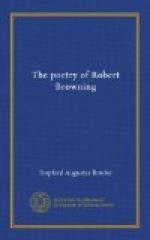We have seen with what force in Sordello he realised the life and tumult of the thirteenth century. The fourteenth century does not seem to have attracted him much, though he frequently refers to its work in Florence; but when the Renaissance in the fifteenth century took its turn with decision towards a more open freedom of life and thought, abandoning one after another the conventions of the past; when the moral limits, which the Church still faintly insisted on, were more and more withdrawn and finally blotted out; when, as the century passed into the next, the Church led the revolt against decency, order, and morality; when scepticism took the place of faith, even of duty, and criticism the place of authority, then Browning became interested, not of course in the want of faith and in immorality, but in the swift variety and intensity of the movement of intellectual and social life, and in the interlacing changes of the movement. This was an enchanting world for him, and as he was naturally most interested in the arts, he represented the way in which the main elements of the Renaissance appeared to him in poems which were concerned with music, poetry, painting and the rest of the arts, but chiefly with painting. Of course, when the Renaissance began to die down into senile pride and decay, Browning, who never ceased to choose and claim companionship with vigorous life, who abhorred decay either in Nature or nations, in societies or in cliques of culture, who would have preferred a blood-red pirate to the daintiest of decadents—did not care for it, and in only one poem, touched with contemptuous pity and humour, represented its disease and its disintegrating elements, with so much power, however, with such grasping mastery, that it is like a painting by Velasquez. Ruskin said justly that the Bishop orders his Tomb at St. Praxed’s Church concentrated into a few lines all the evil elements of the Renaissance. But this want of care for the decaying Renaissance was contrasted by the extreme pleasure with which he treated its early manhood in Fra Lippo Lippi.
The Renaissance had a life and seasons, like those of a human being. It went through its childhood and youth like a boy of genius under the care of parents from whose opinions and mode of life he is sure to sever himself in the end; but who, having made a deep impression on his nature, retain power over, and give direction to, his first efforts at creation. The first art of the Renaissance, awakened by the discovery of the classic remnants, retained a great deal of the faith and superstition, the philosophy, theology, and childlike naivete of the middle ages. Its painting and sculpture, but chiefly the first of these, gave themselves chiefly to the representation of the soul upon the face, and of the untutored and unconscious movements of the body under the influence of religious passion; that is, such movements as expressed devotion, fervent love of Christ, horror of sin, were




